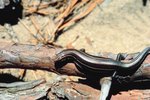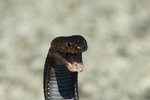
Cobras are a group of snakes from the family Elapidae, native to Africa and South Asia. Cobras do not represent a single lineage of snakes, but rather a group of different, yet related species and lineages. Naja, Ophiophagus and Aspidelaps are a few representative genera. In the wild, cobras are important food sources for predatory birds and large lizards. To defend themselves from these threats, cobras use some tactics common to all snakes and some that are uniquely developed.
Hiding and Crypsis
The first predator avoidance strategy of most snakes is to simply avoid detection. Many cobras are clad in colors that provide very effective camouflage in their natural habitats. When cobras are in a good hiding space, they will also remain motionless, which makes it harder for visual hunters like birds to find them. Other cobras are nocturnal and avoid predators like birds entirely. In all cases, cobras will hide while sleeping, preparing to shed or digesting a meal. Their preferred hiding spots are in tree hollows, deep rodent burrows and under large rocks.
Hooding
One of the most famous defensive mechanisms in the entire animal kingdom is the hood of the cobra. When frightened, a cobra will raise up to one-third of its length off the ground, and through physical adaptations, spread the anterior most portion of its ribs. The ribs pull the skin and scales taught, and through the display, the cobra looks much larger and more intimidating. The various genera have developed different hoods; some hoods are very broad, making an oval-shaped silhouette, while others produce a longer, rectangular hood shape. Cobras aren't the only snakes that try to ward off predators with a hood; a number of other elapid species display a weak hood. Even completely unrelated species, like the North American hognose snakes (Heterodon sp.) have hoods that are displayed horizontally, which reinforces the idea that hoods are effective anti-predator mechanisms.
Venomous Bite
All cobras are venomous, and some are capable of killing large predators like humans. While a cobra's bite is an effective defense, it is one of the last resorts most individuals will employ. Cobra venom is delivered through a set of fixed fangs, located in the front of the mouth. The venom of cobras is typically neurotoxic, meaning that it interferes with nerve impulse transmission. Animals that die from cobra bites usually succumb due to paralysis-induced asphyxiation.
Spitting Venom
A few species of cobra are able to spit venom at perceived threats, which can keep an adversary at bay. By producing high pressure, the snakes can shoot venom out of holes on the forward-facing surface of their fangs. Some species have been known to spit venom up to 8 feet. In most cases, the venom causes pain on contact with the eyes, and if not treated appropriately, can cause permanent blindness.
References
Photo Credits
-
Digital Vision/Digital Vision/Getty Images




